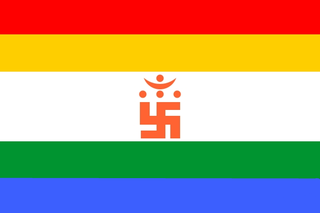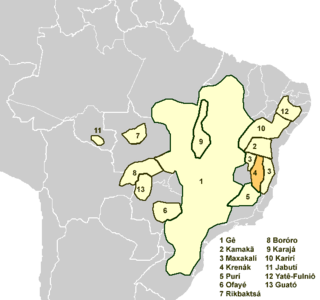| Panca | |
|---|---|
| Scientific classification | |
| Kingdom: | Animalia |
| Phylum: | Arthropoda |
| Class: | Insecta |
| Order: | Lepidoptera |
| Family: | Hesperiidae |
| Subtribe: | Moncina |
| Genus: | Panca Evans, 1955 |
Panca is a genus of skipper butterflies in the family Hesperiidae.
| Panca | |
|---|---|
| Scientific classification | |
| Kingdom: | Animalia |
| Phylum: | Arthropoda |
| Class: | Insecta |
| Order: | Lepidoptera |
| Family: | Hesperiidae |
| Subtribe: | Moncina |
| Genus: | Panca Evans, 1955 |
Panca is a genus of skipper butterflies in the family Hesperiidae.
Recognised species in the genus Panca include: [1]
Temenggong or Tumenggung is an old Malay and Javanese title of nobility, usually given to the chief of public security.

Pancas is a Brazilian municipality in the state of Espírito Santo. Its population was 23,306 (2020) and its area is 838 km². East Pomeranian, a dialect of Low German, has co-official status in Pancas.
East Pomeranian (Ostpommersch) is an East Low German dialect that is either moribund or used to be spoken in what was roughly Pomerania and today is also spoken in some communities in Brazil. It is part of the Low German language.

The Ṇamōkāra mantra or Navkar Mantra is the most significant mantra in Jainism, and one of the oldest mantras in continuous practice. This is the first prayer recited by the Jains while meditating. The mantra is also variously referred to as the Pancha Namaskāra Mantra, Namaskāra Mantra, Navakāra Mantra, Namaskāra Mangala or Paramesthi Mantra.

Pancha Tattva in the Gaudiya Vaishnava tradition of Hinduism refers specifically to the Five aspects of God or Absolute Truth.
Pāradas was an Iron Age kingdom described in various ancient and classical Indian texts. The exact location of the kingdom is unknown. The Vayu Purana locates the tribe on the upper course of the Amu Darya and Syr Darya rivers in Central Asia. The Mahabharata, however, associates the Paradas with the tribes of Uttarapatha, and places them on the Sailoda River in the Xinjiang province of China. Additionally, the Ramayana locates the people in the Himalayas.

The Pañca-Parameṣṭhi in Jainism are a fivefold hierarchy of religious authorities worthy of veneration.

Jain symbols are symbols based on the Jain philosophy.

The flag of Jainism has five colours: white, orange, red, yellow, green and blue. These five colours represent the Pañca-Parameṣṭhi. It also represents the five main vows of Jainism.
Sura or Sooraa is a strong distilled alcoholic drink originating from the Indian subcontinent. It is referred to as an anaesthetic by Suśruta. Other ancient medical authorities also mention it; Charaka referred to making a woman with a miscarriage senseless to pain by administering alcoholic drinks like sooraa, sīdhu, ariṣṭa, madhu, madirā or āsava.

Shambar is a soup that blends many ingredients, tastes, and seasonings from Spanish, Criollo and Andean cultures, considered the most traditional meal in Trujillo's gastronomy in Perú. From Otuzco Peru. It is made of wheat grains, fava beans, green peas, chickpeas and dry beans. It must have three kinds of meat, including chicken, ham, beef, and pork skin, ears or tail. The seasoning is done with a blend of garlic, black pepper, cumin, purple chilli pepper, yellow chilli pepper, parsley and vegetable oil.
The Sovereignty Party was a political party in Indonesia and a contestant in the 2009 elections.

The Aimoré, Botocudoan or Borum languages, now sometimes known as Krenakan after the last one remaining, are a branch of the Macro-Jê languages - spoken mainly in Brazil - including moribund Krenak and extinct languages such as Guerén and Nakrehé. Loukotka (1968) considered them dialects of a single language, but more recent treatments describe at least some of them as separate languages.
The Palace and Gardens of Panaca, sometimes characterized as the Palácio Palha is a palace within the Santa Engrácia area of the civil parish of São Vicente, in the municipality in the Portuguese capital of Lisbon.

The Datsun Go/Go+ is a city car and mini MPV with "5+2" seating capacity that was produced by the Japanese automaker Nissan under the Datsun brand between 2014 and 2022. Named after the "Dat-Go", Datsun's first car launched in the early 20th century, the Go was available in developing markets such as India, South Africa and Indonesia. It is built on the same V platform as the K13 Nissan Micra/March, from which it has inherited much of its components.

Pura Maospahit is a Balinese Hindu temple or pura located in Denpasar, Bali. The pura is known for its bare red brick architecture, reminiscent of the architecture of the 13th-century Majapahit Kingdom, hence the name. Pura Maospahit is the only pura in Bali which was built using a concept known as Panca Mandala where the most sacred area is situated at the center instead of at the direction of the mountain.
Panca is best known as a genus of butterflies - Panca (butterfly) but also:
Sancho Pança dans son isle is a 1762 opera by François-André Danican Philidor to a libretto by Antoine-Alexandre-Henri Poinsinet. It premiered at the Comédie Italienne on July 8, 1762.
Pancha Pakshi Shastra is a system of divination historically popular among Hindu astrologers of southern India.